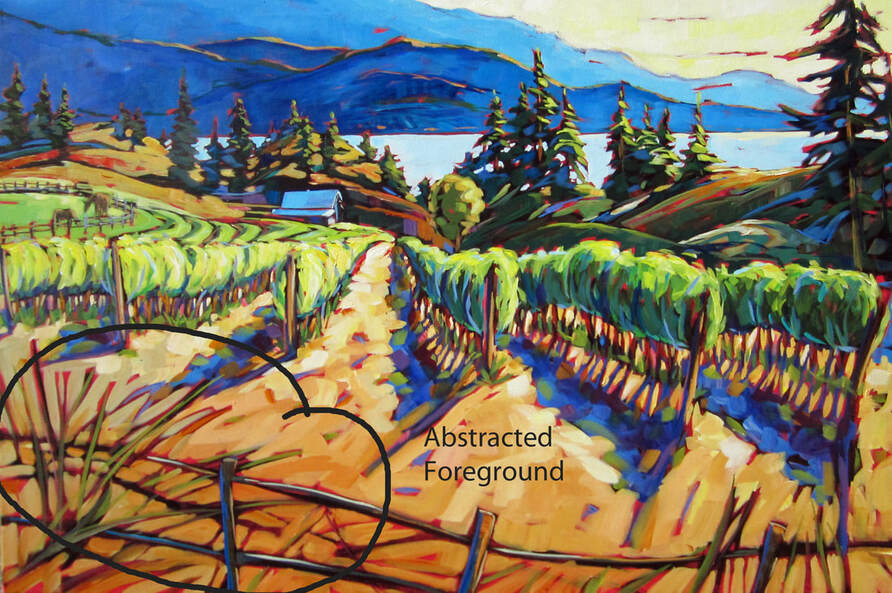|
Once in a while, it's a good exercise to try to limit one's palette to work more with tonality and saturation. Choose 2-3 analogous colours (beside each other on the colour wheel) and go at it. You will get a harmonious painting that shows you that composition is way more important than using a broad variety of colours.
0 Comments
Now there is nothing wrong with having four corners the same in a painting. It makes the painting look more like a vignette, a technique used in the past in which the border of the image is blurry. But, if you want a more dynamic looking painting, it's a good idea to pay attention to all four corners and make sure they are all different. I does not always work perfectly but it adds "un je ne sais quoi" to your painting. Try it next time. It also reminds you to use gradation and not paint a large area all the same tone or colour. It's good practice!
I have heard of artists taking their paintings into galleries in the hope to be represented and having the gallery owner get real close to the painting in order to examine it. You know what they are looking at so carefully? It's the stroke quality. The decisiveness of the stroke, the control of the edges (soft or hard), the way the paint brush is manipulated. It's a good way to judge if a painter is a beginner or an experience painter. Because it takes some time to be able to load up the paintbrush and apply the paint with conviction and energy, without unwanted frayed edges or smears. So feel free to practice the swing of the wrist, that softness of the pressure on the brush, remember that paintbrush are make with long handles for a reason. Use them and you will be surprise by the joyful strokes you can produce with practice.
In an effort to give shapes a tridimensional look, I try to always ensure that each object (including mountains and grasses, everything) has a dark tone, a middle value and some highlights. And that's where knowing precisely where the light comes from is essential in order to position these 3 tonalities. I use to literally stick a little piece of paper with a sun or an arrow on it not to never forget where the light came from and to make sure I darn well showed that. So each bush, pole, rock will have at least 3 tones. Try it, it's a good exercise in mixing paint if nothing else.
Foregrounds can be so difficult to do sometimes. You don't want the viewer to get "stuck" there and not meander further into the painting because you put so much details into your foreground. On the other hand, the foreground is the anchor of the painting. That's why I like to make mine often colorful but abstracted to that it may be interesting without being arresting. The devil is in the details, they say...
I find it more interesting to divide a "sky and water" painting so that the 2 parts are unequal. You can decide which one will be bigger but they are less likely to compete if they are given different size portions (the opposite of real life with two four-year old kids sharing a pop).
Purposely try to direct the eye of the viewer from the most likely entry point to around the painting. A little attempted manipulation is not illegal, right? Apparently, most people in the western world scan a painting from left to right because that is how they learn to read. Once the viewer "enter" the painting, it's ok to use shapes within the painting to influence where their gaze will travel. The longest the travel, the better.
You want to created a harmonious painting, a painting that creates a sense of calm or order? Using fewer colours and using analogous colours will do just that. Analogous colours are the ones that are close to each other on the colour wheel. Like yellow and orange or yellow and light green, or blue and bluish purple. Sometimes, simplifying one's palette can leads to beautiful results.
Negative painting is at the centre of what I do, how I paint. It's often where the fun is or where the tricky stuff comes in. When someone paints the sky first and then the land and then paints the trees and the houses on top, that's called positive painting. When someone starts with an underpaint (covering the entire canvas with a given colour, and mine is a kind of quidacridone red), then draws in the shapes with little attention to details (I do it in black) but then comes in, per example, with the blue of the sky to form the shape of the trees, or the colour of the rocks to outline the grasses near by, that's called negative painting. Tom Thompson was a negative painter and I once read that his Group of 7 friends complained that he was grumpy because he always had to paint the space (sky) between all the leaves and branches, which was tricky and sometimes tedious. But I so enjoy creating shapes with a loose version of negative painting, leaving a fair bit of the underpainting showing up beside the shapes. These little unpainted areas are called Holidays. Cute, isn't it?
How about trying to use a strong and unusual points of view? From way above or from the ground up? It add interest and it's easier to direct the viewer in the direction you want them to go within the painting.
|
Archives
November 2020
Categories |













 RSS Feed
RSS Feed
